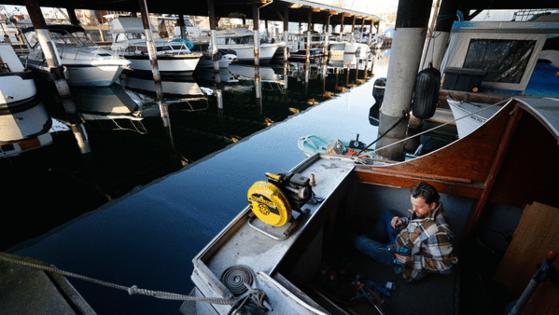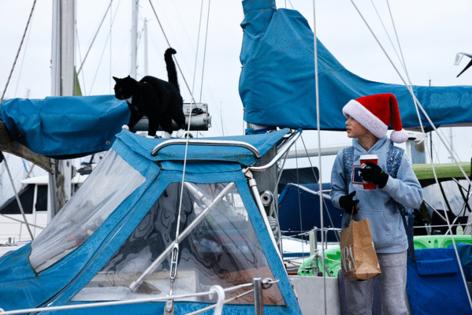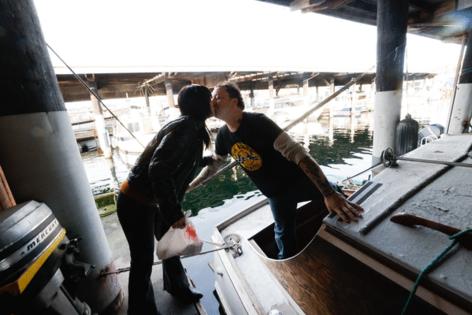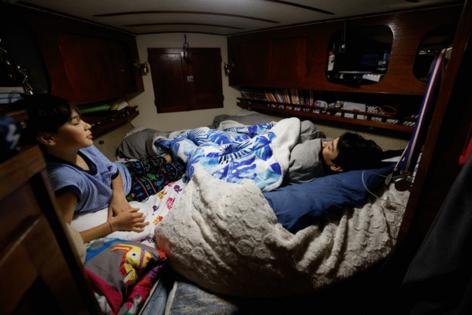Living on a boat in Seattle used to be cheap. Who still opts for liveaboard life?
Published in Business News
When Michael and Rie DePaula decided to relocate to Seattle, they realized they would need to be creative in the hot housing market.
It was 2017, and the couple saw the move as career advancement for Michael, 46, and an English immersion opportunity for their three sons, who had been born and raised in Japan.
Home prices were high and renting seemed like throwing money away. So Michael proposed an extraordinary third option: Why not live on a boat?
The idea wasn’t really outlandish.
“We had the dream a decade prior to circumnavigate” the globe, said Michael. “In a place like Seattle, I realized this was our chance.”
In October 2017, Michael purchased a 53-foot-long 1973 Spencer ketch rig sailboat from a seller in Anacortes. Valued at about $150,000, it has three bedrooms, one bathroom, a living room, a dining area and a kitchen. The next year, he’d secured a spot to dock it at the Port of Seattle’s coveted Shilshole Bay Marina, located just south of Golden Gardens Park.
By September 2018, the entire family was on board, literally. They named their boat “Sumebamiyako,” a Japanese proverb that translates to “Home is where you make it.”
The DePaulas are among the city’s hundreds of liveaboards — a term referring to both the people who live on boats and the vessels themselves. It’s difficult to say exactly how many liveaboards there are in the city because many do so part-time or even under the table. Still, Shilshole Bay Marina is one of the biggest liveaboard communities on the West Coast, with up to 350 households living in its more than 1,500 boat slips. The dozens of private marinas dotting the city’s shorelines host countless more.
Liveaboards cite a range of reasons for the lives they choose. They find themselves drawn to the water, unique lifestyle and sense of freedom embedded in both.
Historically, boat living was also far more affordable than living in an apartment or a house in Seattle. That’s not always the case anymore, as demand for moorage — long-term boat parking — has driven up the expense.
Michael and Rie’s kids — Aiden, Joel and Ze, now aged 18, 15 and 12 — are well-adjusted to boat life’s idiosyncrasies. On a damp, slate-gray morning in December, the Sumebamiyako came alive as they woke up one by one, joining their mom in the kitchen as they got ready for school. Rie, 49, stood in the galley, or the kitchen, making onigiri rice balls.
“When we moved here, I didn’t know that we were gonna move into a boat,” Ze said. “I was excited because I used to like ‘Moana’ a lot.”
The three boys ate breakfast in the dining nook while one of the family’s two cats, Max, skittered around the deck outside. (The other cat is Eureka; they also have a dog, Leo.) A mandarin orange somersaulted around the table as the boat swayed imperceptibly. The boat’s wooden walls are lined with blankets and books, packed neatly and tightly in the compact space.
The kids share two bedrooms among the three of them. Most days, they’re busy enough that they’re out of each other’s way, spending time at the gym, baseball practice, Starbucks or school. That said, everyone agrees that a little extra room would be nice.
“I feel like my family is always within five feet,” Aiden said.
Rie misses having a normal kitchen, one that can run multiple electric appliances at once. “It’s kind of small and very inconvenient,” she said. Meals take a while to prepare on the Sumebamiyako; she can’t run the rice cooker and the microwave at the same time. On the other hand, she said, “the sunsets are beautiful.”
Until last August, Michael worked at Meta. Now, the family is temporarily living on savings and unemployment payments while Michael prepares to start a coin shop business. The family doesn’t plan to move onto land any time soon. One day, they hope to sail the world on the Sumebamiyako.
“If we didn’t jump at the time we did, we probably would have been renters the entire time,” Michael said. Other families might have chosen that more traditional path. “We decided to go with the dream option.”
Paradise comes at a cost
It’s not easy for liveaboards in Seattle. First, you need a boat, then a place to store it.
The half-dozen marina managers who spoke with The Seattle Times said they field calls each week inquiring about slips, particularly those with a liveaboard option. The city’s marinas are virtually full, with waitlists that stretch months or even years.
Interest in boat living increased dramatically in recent years, said Todd Pearson, general manager of Harbour Village Marina, a private facility in Kenmore on Lake Washington. He attributes this to the stubbornly high cost of housing in the Seattle metro region. “There’s young people that are promoting liveaboards as a cheap alternative.”
But liveaboards contend with a host of expenses that most people don’t have to think about, from vessel fees to niche services. Maintenance, like plumbing or electrical repairs, is pricier on a boat because of the specialized expertise required to perform it.
And not even liveaboards can escape the cost-of-living pressures in Seattle, where marinas charge some of the highest moorage rates in the state.
For those who do find a slip, there’s often a separate wait to get liveaboard status. Many marinas cap the number of liveaboards they allow due to facility limitations or environmental regulations.
Erin Graf, 40, and Darryl Brown, 43, were on the Shilshole Bay Marina waitlist for three years before the right spot became available. Prior, they’d lived at a private marina that was less scenic and more industrial.
By comparison, their current home is like a resort that looks out onto the Olympic Mountains. “Shilshole Bay Marina is probably one of the most beautiful places to live in the world,” Graf said.
But paradise doesn’t come cheap.
Monthly moorage for liveaboards begins at just under $500 per month for an 18-foot slip, the smallest length available, and rises to $3,200 per month or more for slips measuring 111 feet or longer. Residents also pay a 12.84% tax on their total monthly charges.
For a 60-foot slip — a common length for liveaboards and what Graf and Brown have — the monthly cost is almost $2,000 now. That’s a steep increase compared to what it cost as recently as 2018, when it was slightly under $1,200, including fees and taxes. Every year, the Port of Seattle conducts a survey of regional marina prices and raises its own accordingly.
(While most liveaboards consider their monthly moorage to be akin to rent, they don’t get the same protections as tenants living on land. And unlike a house or condo in Seattle, boats depreciate in value over time.)
On top of moorage, liveaboards pay for most of the same utilities as people on land, from electricity to internet to sewage. (Water is included.) But they may face additional expenses, depending on their needs. Graf and Brown spend $180 a month on a storage unit for everything they can’t fit on their boat, and $236 a year on a P.O. box for important mail.
Liveaboards also incur all the usual costs of boat ownership. Recently, Graf and Brown spent $5,000 upgrading the electrical panels on their 1980 Canoe Cove motor vessel, which originally cost $130,000.
The couple makes $240,000 a year. For now, their cost of living is comparable to renting but cheaper than buying.
As Brown sees it, if they lived in an apartment, they’d still have to contend with unpredictable housing prices. It’s not surprising that the fluctuations of the Seattle market followed them on board. But Graf feels differently.
“I feel comfortable where we are,” she said. “But if the rates continue to increase as they are over the next 10 years, I would be concerned about being able to stay in this lifestyle.”
‘Intimate and intentional living’
Ryan Currier didn’t want to leave Ballard.
For the 43-year-old musician and mechanic, the neighborhood was more than just a place to live — it was a tether to his artistic community and Seattle’s fading maritime industry. But in 2019, he had to move.
Finding an apartment within his budget seemed impossible: His rent had quadrupled in the decade and a half since he first moved in.
So he moved onto his boat, a 1940 Ed Monk wooden sedan cruiser. Currier had purchased the vessel for $10,000 in the early 2000s and kept it docked at Sagstad Marina, a private facility on Salmon Bay just a stone’s throw from Ballard’s main commercial strip.
“I could either have an apartment that would continue to go up in cost, or I could put some more effort into my boat and make that into the home that I always wanted to be,” he said. In doing so, “I was able to stay in Ballard.”
On a sunny winter day, Currier took tacos out of their to-go containers in a kitchen no larger than an office cubicle. Above his head dangled miniature cookware. Whatever doesn’t fit on the boat goes into a storage unit.
Currier no longer pays rent in the traditional sense. He simply continues to pay his monthly moorage fee, the cost of parking a boat at the marina, plus a monthly liveaboard charge to live on his vessel full time. (Those who don’t pay that charge are restricted to living on board 14 days per month at maximum.) Currier declined to share his monthly income, but he said his housing costs have gone down by about 30% since becoming a liveaboard.
Currier is somewhat of an anomaly. Because he’s a mechanic, he’s capable of — and, in fact, enthused about — fixing up his boat on his own. He spends 5 to 10 hours a week working on projects, keeping maintenance costs far lower than what they typically would be.
He’s seen other people try to become liveaboards, only to eventually give up after the high costs of maintenance became apparent.
“‘Boat’ is an acronym for ‘break out another thousand,’” Currier joked.
His space may be small, but his life feels full. Currier’s girlfriend, Liberty Bordeaux, 46, lives in the boat across the dock from his, having become a liveaboard herself in 2023. She has a cat, and he a dog. Both walk to work from the marina. In the evenings, they drink wine and listen to the records that line the walls of Currier’s living room. At night, they sleep in a Murphy bed that Currier installed himself.
In small spaces, only the necessities end up on board, Bordeaux said. She downsized significantly when she left her apartment, moving onto a 32-foot 1974 Trojan Sedan. She regrets nothing. “It’s more intimate and intentional living.”
The community at Sagstad Marina is small but tightly knit. In the summer, Bordeaux, a barber at Rudy’s, gave her neighbors haircuts at the end of their dock — a de facto community gathering space where residents drink and watch the sunset when the weather is nice. On the last day of 2024, Currier and a few former liveaboards got together to play music in the marina’s woodshop, ringing in the new year together.
Living alternatives
Confronted with rising costs in Seattle, some liveaboards are more likely to give up on the city rather than the boat.
Pamela Pakker-Kozicki, 69, and her husband are retirees who have been on-and-off residents of Shilshole Bay Marina since 2007. They’ve never owned property on land, and even raised their kids on their boat, which they bought in 1995 for $45,000.
The couple’s monthly moorage costs went up by more than $200 this year, and they’ve begun considering ports outside King County. In Bremerton, one of their options, the moorage charge would be half of what it is in Seattle, she said.
Even prior to the 2025 increase, Pakker-Kozicki said, they’d been paying more for their slip “than a lot of my friends are paying for their mortgage.”
In theory, a liveaboard could simply sail away in search of cheaper shores. But the freedom to leave doesn’t actually make it easy to do so, especially once a marina has become home.
A move to Bremerton would cost Pakker-Kozicki her neighbors, her church, her friends in the fishing community from her husband’s former work as a fisherman and her medical support system.
“Uprooting us from here would be difficult,” she said. “But what’s the alternative?”
Teresa Wagner, 59, and Eric Bischoff, 71, have lived at Shilshole since 2013 on a 67-foot-long Ed Monk power boat. Their income comes from Social Security payments and from running Jibe Espresso Bar, a coffee shop and hangout spot for marina residents.
“My commute is 227 steps,” Wagner said.
Before Shilshole, the couple lived in a house in Seattle’s Northgate area. Becoming liveaboards represented adventure and fun — and it was cheaper than making mortgage payments. But as the cost of moorage has gone up year after year, Wagner said, that’s no longer the case.
The couple are feeling particularly squeezed right now. Business slows to a crawl in January and February. Meanwhile, Seattle’s minimum wage just went up, increasing their labor costs substantially. They are re-evaluating how to make ends meet in both work and life.
“We’re thinking about selling the boat and downsizing,” she said. With a smaller boat, they could get a smaller slip, reducing their costs.
Reluctantly, some are considering a move back to land.
Dana Brooks, 57, has been a liveaboard at Shilshole Bay Marina for over a decade, living and working remotely as a veterinary internal medicine consultant on her 1972 Challenger sailboat, which she bought for $25,000, with her cat Tugboat.
Recently, Brooks and her boyfriend, who lives in a studio in Mountlake Terrace, have begun to discuss moving in together. If she wanted to stay at Shilshole, she’d need a larger boat to accommodate two people, meaning they’d also need a larger slip — estimated wait times for which run up to about a year or longer.
The more practical option is the less desirable one: relinquishing boat life and finding an apartment on land. In the past, Brooks could afford both rent and moorage at the same time. Price increases at the marina and in the Seattle housing market over the last decade mean that it’s now one or the other.
Giving up liveaboard life was unimaginable to Brooks until recently.
On the water, she feels most calm. She’s grown to care for her neighbors, much more than she ever did in a condo. She likes to watch seals splash and eagles dive. The last time she lived on land, she stayed at an Airbnb following a knee replacement surgery. She remembers feeling tense until the moment she was back on board.
As expensive as the lifestyle has gotten, she’s still holding out for a way to keep close to the water. “If for whatever reason the relationship doesn’t work out, I’m staying put.”
©2025 The Seattle Times. Visit seattletimes.com. Distributed by Tribune Content Agency, LLC.





















Comments